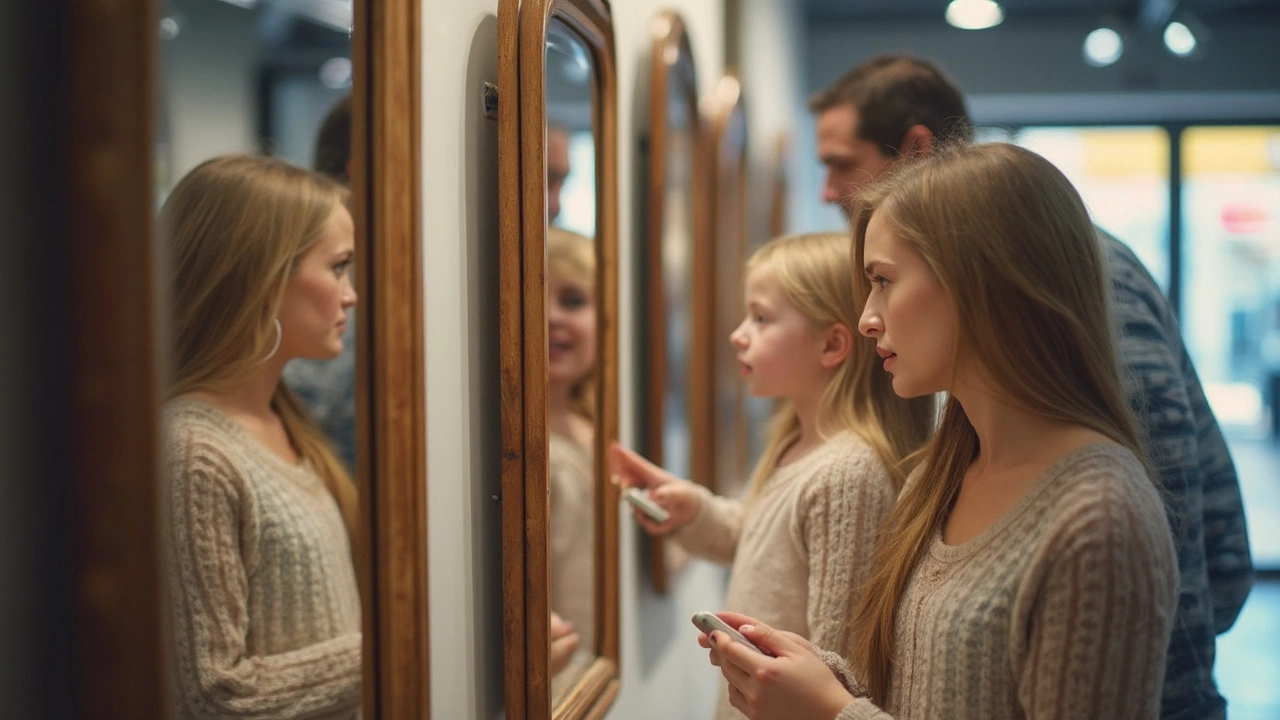What Type of Mirror Makes You Look Larger? The Real Answers
 May, 11 2025
May, 11 2025
Mirrors are sneaky. Ever been to a fitting room and felt like you suddenly gained a few pounds? Or maybe you catch a glimpse of yourself at home and wonder if you shrunk two inches. It’s not your eyes playing tricks—it’s the type of mirror staring back at you.
So, what type of mirror makes you look larger? The quick answer: concave mirrors that curve inward, and even some low-quality flat mirrors, can make you look a lot bigger than you actually are. Most of us think all mirrors show the truth. They don’t. The tiniest curve in a mirror’s surface—even just a slight bow or dip—will warp your reflection, squashing or stretching you in ways you probably weren’t expecting.
This isn't just a random glitch, either. Stores sometimes use slightly curved mirrors in dressing rooms to change how customers see themselves. Some make you slimmer (everybody likes those, right?), but others do the opposite. Home mirrors can be just as hit-or-miss. Cheap ones often warp over time, which means your reflection might be lying to you every morning.
- What Shapes and Curves Do to Your Reflection
- Why Some Mirrors Distort the Truth
- Spotting Illusion Mirrors in Real Life
- Tips for Choosing the Best Mirror for You
What Shapes and Curves Do to Your Reflection
The way a mirror is shaped changes everything about how you look in it. Most of the time, you want a flat mirror, which gives an accurate picture. But once you start dealing with curves—either bending in or sticking out—the game totally changes.
Mirror shape is the real trickster. Here’s how it works:
- Concave mirrors: These curve inward, kind of like a spoon. Stand the right distance from one, and you’ll look bigger than you are. This is because they focus light, squashing your reflection closer together and making your image appear stretched and wider, especially near the edges.
- Convex mirrors: These puff outward, making you look smaller or skinnier. That’s why cars use them for side mirrors, so they can show more area—but you always look shrunken in them.
- Flat mirrors: The honest ones—they give you a true, proportional image, assuming their surface isn’t warped or bent.
Now, even mirrors that are supposed to be flat can get a bit wavy or warped over time, especially cheaper ones or those with thin glass. That slight warp might not seem like much, but it can add or take away inches from your reflection.
Here’s a handy cheat sheet for what mirror shapes actually do:
| Mirror Type | Shape | Distortion Effect | Common Use |
|---|---|---|---|
| Flat | No curve | True image | Home, bathrooms |
| Concave | Curved inward | Makes you look larger if standing close | Makeup mirrors, some dressing rooms |
| Convex | Curved outward | Makes you look smaller | Vehicle side mirrors, security |
There’s actually science behind all of this—when you stand close to a concave mirror, it magnifies your features. But step too far back and you can actually get a flipped, upside-down version of yourself. That rarely happens in a dressing room, but it’s a fun party trick at the science museum.
If you’re ever unsure why you look strangely wide or short in a mirror, check the shape first. Grab a straight object—like a ruler or even your toothbrush. Place it along the mirror. If you see a gap, it’s probably a concave mirror. If the center touches before the edges, it’s more convex. Quick and simple way to spot the culprit.
Why Some Mirrors Distort the Truth
Mirrors aren’t magic—they’re all about physics. The way a mirror reflects light determines whether it shows your true size or messes with your appearance. Here’s where things get interesting: the tiniest bend in the glass changes everything.
The most common reason a mirror distorts your look is shape. A perfectly flat mirror is hard to make, especially if it’s cheap. When a mirror curves slightly inwards (concave), it acts like a funhouse mirror and makes you appear wider or larger. Flip it around, and a mirror that bows outward (convex) can make you seem slimmer.
This isn’t just about big obvious curves either. Sometimes, even a small wave or sag in the middle does the trick. Manufacturing flaws, thin glass, or even how a mirror is mounted can bend it without you noticing. I once had a bathroom mirror that made me look like a pro wrestler—Charlie the dog even barked at it a few times, probably thinking I was a giant stranger.
Here’s what causes most mirror distortion:
- Curved glass: Concave mirrors focus light inward, so your image gets stretched sideways and seems puffier. Convex mirrors do the opposite, shrinking or narrowing you.
- Poor quality control: Cheaply made mirrors often aren’t perfectly flat. Over time, they can bend from their own weight or from being hung unevenly.
- Bad mounting: If a mirror isn’t on a totally flat surface or is held tightly on one edge and loose on another, it’ll twist ever so slightly, messing up your reflection.
Sometimes, it’s not even the mirror itself, but thick or uneven backing. Mirrors glued onto walls with patches of glue instead of a totally even layer will warp over time—so keep an eye on how your mirrors are installed.
If a mirror suddenly makes you look different compared to your phone’s selfie camera, chances are it’s not your diet or posture. It’s probably a curved or bent mirror sabotaging your day.

Spotting Illusion Mirrors in Real Life
If you’ve ever wondered why you look totally different depending on where you check your reflection, you’re not alone. The main culprit? Mirrors that don’t have a perfectly flat surface. Even a tiny curve can mess with your looks—especially those sneaky fitting room mirrors. The mirror itself might be telling a different story than reality.
Here’s what to look for if you want to catch an illusion mirror in action:
- Check the edges. Lay a straight object (like your phone or even a credit card) flat against the mirror’s surface from top to bottom and side to side. If you see gaps or wobbles, that’s a sign of a curved or warped mirror.
- Look for weird stretching or shrinking. Stand close, then a few feet back. Do your arms or legs get longer, shorter, or wider as you move? That’s not magic. That’s distortion.
- Test with a grid pattern. If the mirror is in a store, grab something with a known pattern, like a striped shirt or plaid jacket. The lines should look straight. Bends or waves mean the mirror isn’t flat.
- Compare with your phone’s camera. Snap a quick selfie in front of the mirror, then compare it to your reflection. If something looks way off, odds are the mirror’s the issue.
Some stores actually prefer mirrors that make people appear just a bit slimmer, but a 2017 survey by The Guardian found 22% of shoppers felt more self-conscious after trying clothes in-store— and poor mirror quality was a huge complaint.
| Mirror Type | Common Location | Likelihood of Distortion |
|---|---|---|
| Flat Glass | Home bathrooms | Low |
| Concave (Inward Curve) | Funhouses, some fitting rooms | High |
| Convex (Outward Curve) | Security mirrors, funhouses | High |
| Cheap/Thin Mirrors | Dorms, budget stores | Moderate to High |
Don’t be afraid to ask staff about their fitting room mirrors if something feels off. At home, investing even a little more in a quality mirror helps keep things honest. Learn the trick to spotting distortion early, and you’ll never fall for a warped reflection again.
Tips for Choosing the Best Mirror for You
The search for a mirror that won't mess with your appearance is more about details than you'd think. A big part of it comes down to how the mirror is made and where you plan to use it. Not all mirrors are created equal; even minor differences in shape, thickness, and build quality can change your reflection a ton.
First, pick a flat mirror with a thick glass panel, at least 4 mm. Thin glass is more likely to bend, even if the distortion isn’t obvious at first glance. Always look for mirrors labeled "true reflection" or "high-definition"—these terms usually mean fewer distortions. Thickness matters more than you think because flimsy glass bows and sags over time. Double-check the backing, too; poor support means the glass can warp, especially in areas with temperature swings.
Here's a quick checklist to spot a good-quality mirror, whether at a store or online:
- Inspect Head-On and From Angles: Look into the mirror straight-on, then from different sides. Any funhouse weirdness or wavy lines? Walk away.
- Tap the Glass: Thicker mirrors sound dull, like a thud. Thin or low-grade mirrors sound sharp or tinny.
- Flatness Test: Hold a ruler or straightedge to the surface. Gaps mean unevenness.
- Check the Back: Quality mirrors use strong backing (metal or sturdy plastic) to keep that glass flat over time.
Shopping online? Read reviews like your sanity depends on it, especially the low-star ones—people love to rant about wobbly, warped mirrors.
If you’re putting the mirror in a spot with moisture (bathroom, laundry, etc.), moisture-resistant backing is a must. Otherwise, that steamy shower will start warping things pretty quickly. For big wall mirrors or full-length ones, always anchor them properly so they don’t tilt and create subtle curves over months or years.
Here’s a quick breakdown of what matters most—use this table so you don’t forget:
| Feature | Why It Matters |
|---|---|
| Glass Thickness (4mm+) | Stays flat, less likely to bend or warp |
| Solid Backing | Keeps glass straight over time |
| Moisture Resistance | Crucial for bathrooms/steamy places |
| Edge Finish | Reduces chipping, keeps it safe |
| Label: “True Reflection” | More reliable accuracy |
Ever noticed how store mirrors can look different depending on the light? Lighting changes how you perceive the image—cool-white light often looks more flattering than harsh yellow. Place your home mirror in an area with even, natural light. Avoid weird shadows if you want a reflection that actually helps, not hinders.
One of the top mirror manufacturers, Guardian Glass, sums it up nicely:
"High-quality mirrors deliver an exact copy of whatever is in front of them, so you get a faithful, undistorted reflection every time."
In the end, don’t ignore the nitty-gritty. Take five extra minutes to check the details, and your mirror won’t turn your reflection into an unintentional circus act.